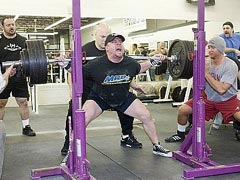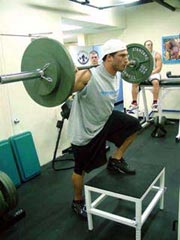 In the 1920s - particularly in the US - weight training began gaining favour with the public at large, and the Step-up began finding itself in various books and magazines. However, the back squat gradually started to dominate (largely due to the efforts of the German Henry 'Milo' Steinborn and Joseph Curtis Hise) and the Step-up was all but forgotten.
In the 1920s - particularly in the US - weight training began gaining favour with the public at large, and the Step-up began finding itself in various books and magazines. However, the back squat gradually started to dominate (largely due to the efforts of the German Henry 'Milo' Steinborn and Joseph Curtis Hise) and the Step-up was all but forgotten.
The Step-up seems to have been largely forgotten as a weight-bearing exercise for the thighs - primarily due to the dominance of the back squat. This article may just make you reconsider its use.
What is it?
The Step-up - as the name implies - is nothing more complex than stepping up onto an object, then stepping back down from it. Although it is an incredibly simple exercise, there are a few things to be aware of.
Factors to consider
Perhaps the most important of these is the height of the step. The basic exercise works the hips and thighs, and the step height adjust things in favour of the quadriceps or hamstrings. A higher step works the hamstrings harder, a lower step targets the quads (1).
According to Anatoly Bondarchuk, the 'normal' or ideal step height (for those with perfectly balanced quad and hamstring strength) is such that when the leading leg has the foot flat on the step, and the corresponding thigh parallel to the ground, the trailing leg has the toes just touching the ground (but the heel elevated) (1). This will naturally vary from person to person, and the use of a weight plate is common to bridge small gaps (it's unlikely that your training partner will have exactly the same requirements as you).
In addition to the step height, speed and number of reps both play crucial roles in determining the effectiveness of this exercise (for your personal goals). The usual rules apply - in general the reps will be lower and the breaks longer when training for maximum strength, and the reps higher/breaks shorter for hypertrophy goals.
The starting/finishing distance of the feet from the step also makes a difference, with a larger gap emphasising the Gluteus Maximus and a smaller gap emphasizing quadriceps (2).
Muscles used
The target muscle group is usually the quadriceps, though the weighting of this can be adjusted by altering the step height and gap as indicated above. Other muscle groups involved are (2) :
Synergists
* Gluteus Maximus
* Adductor Magnus
* Soleus
* Gastrocnemius (Second Leg)
Dynamic Stabilizers
* Hamstrings
* Gastrocnemius (First Leg)
Stabilizers
* Erector Spinae
* Trapezius, Upper
* Trapezius, Middle
* Levator Scapulae
* Gluteus Medius
* Gluteus Minimus
Antagonist Stabilizers
* Rectus Abdominis
* Obliques
As you can see, this is well and truly a compound exercise, and targets similar muscle groups to the squat.
Variations
Bodyweight step-up
The simplest form is a bodyweight-only step-up onto anything of a reasonable height (usually something below knee height). The speed, number of reps and step height will all play roles in the effectiveness of this exercise for your goals. Because of this flexibility the step-up can be used as a warmup, conditioning or strength training exercise.
Dumbbell step-up
As per the bodyweight step-up, performed whilst holding a dumbbell in each hand.
Barbell step-up
As per the bodyweight step-up, performed whilst holding a barbell across the shoulders in the same manner as for a back squat.
Step-ups wearing a weight vest
As per the bodyweight step-up, performed whilst wearing a weight-vest (such as the V-Max).
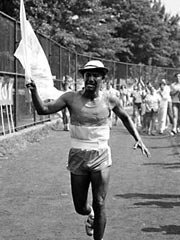 Former East Bengalese marathon runner Sri Chinmoy switched to weight-lifting in the mid 1980s (when he was in his 50s); setting a personal record for Step-ups done whilst wearing a 50lb weight vest by regularly performing 100 in 1996 (aged 65). Once again, the usual rules of rep ranges and breaks apply.
Former East Bengalese marathon runner Sri Chinmoy switched to weight-lifting in the mid 1980s (when he was in his 50s); setting a personal record for Step-ups done whilst wearing a 50lb weight vest by regularly performing 100 in 1996 (aged 65). Once again, the usual rules of rep ranges and breaks apply.
Inspired by Chinmoy's effort, the slightly more spritely Ashrita Furman (6) completed 2,574 step-ups (bodyweight only) onto a 15" bench in one hour, later that same year.
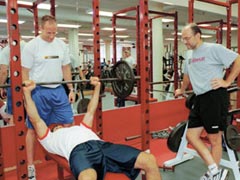 Eric Cressey conducts a
Eric Cressey conducts a 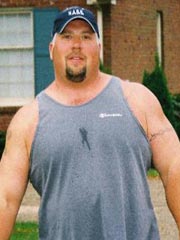 Considering trying your hand at Strongman?
Considering trying your hand at Strongman? 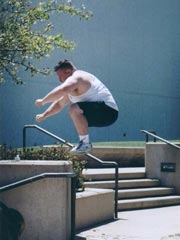 The Sport Fitness Advisor site has an interesting article on the
The Sport Fitness Advisor site has an interesting article on the 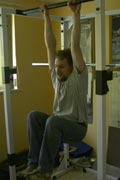
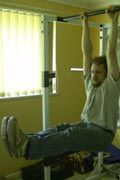 This exercise was born of necessity (not quite enough space in the home gym) : the Hanging Leg Extension. There's enough room to perform
This exercise was born of necessity (not quite enough space in the home gym) : the Hanging Leg Extension. There's enough room to perform  If, like me, you've got
If, like me, you've got 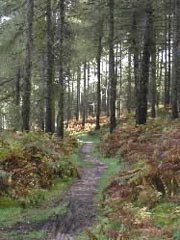 On September 23rd in London's
On September 23rd in London's  I don't need much more of an indicator that I'm feeling less than 100% than missing a scheduled deadlift workout. That's exactly what happened on Monday, and with today's session also absent it feels like I've done little this week other than chin-ups.
I don't need much more of an indicator that I'm feeling less than 100% than missing a scheduled deadlift workout. That's exactly what happened on Monday, and with today's session also absent it feels like I've done little this week other than chin-ups.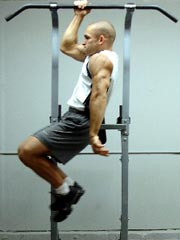 Following
Following 